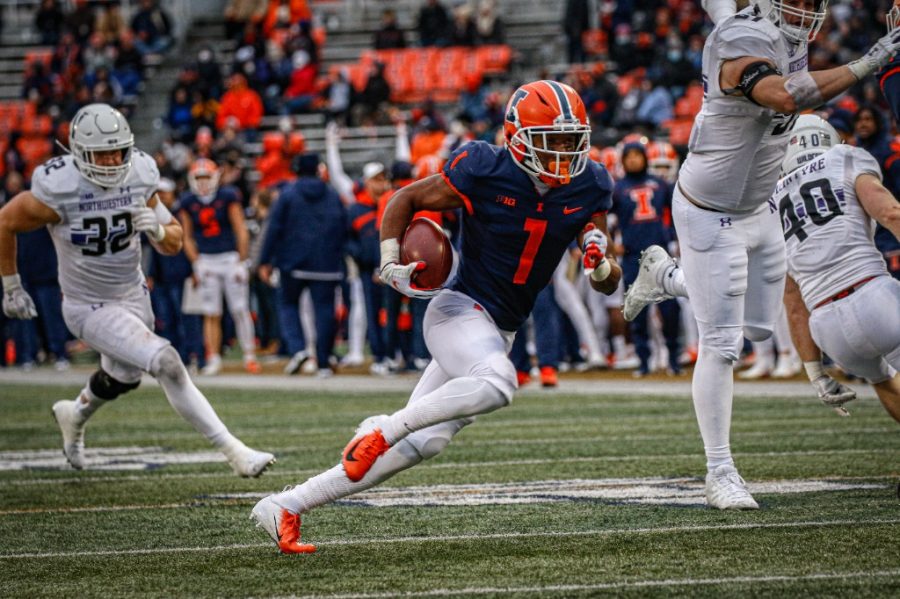Illini offense dominates in first half, uses strong game plan to tame Wildcats
Photo Courtesy of Patrick Pierson / Illinois Athletics
Illinois wide receiver Isaiah Williams runs with the ball during the game against Northwestern at Memorial Stadium in 2021.
Nov 27, 2021
Throughout the season, Bret Bielema has echoed the same sentiment over and over again: Illinois football struggles to play a full four quarters of sound football. Against Northwestern, the Illini didn’t even need four quarters to put the Wildcats away, jumping out to a massive 37-7 lead by halftime
How? Just about everything clicked on offense. Quarterback Brandon Peters played possibly his best half as an Illini, Isaiah Williams hit a career-high in receiving yards, Chase Brown continued his dominance with elite efficiency and offensive coordinator Tony Petersen even sprinkled in some creativity in the play-calling.
Heading into the matchup, it seemed obvious that Illinois would focus on exploiting Northwestern’s weak rush defense, which ranked dead last in the Big Ten in yards allowed per game. Instead, Petersen zagged, cooking up a game plan that involved calling Peters’ number early and often.
The plan was a success from the start. On the first play of the game, Peters wound up and connected with Isaiah Williams for a 25-yard pass, a sign of things to come. That drive would end in a punt, but the Illini would not be held off the board for long.
The Illini had their only three-and-out on the next drive, but Northwestern quarterback Andrew Marty soon dropped the football attempting to pass due to pressure from, the air? Whatever supernatural event caused Marty’s head-scratching mistake, the play resulted in a fumble, which Illinois recovered, placing them on the Northwestern 8-yard line.
Get The Daily Illini in your inbox!
With the game still tied at 0-0, Petersen dug deep into the playbook, dialing up a rush from Daniel Barker for Illinois’ first touchdown.
From that point, the Illini scored on seven consecutive drives. On the next drive, Peters got the call and had absolutely no hesitation. It took all of two plays for him to reach the end zone despite starting at midfield. On his first throw, he connected with Casey Washington for 12 yards to move into Wildcat territory.
On the next play, Peters linked up with Williams for a deep pass, going for 39 yards and the touchdown. This type of play showed tremendous growth on Peters’ part, who struggled with the deep ball all year despite routinely winding up for them. Williams was Illinois’ leading receiver heading into the matchup yet averaged less than 39 yards per game.
Williams had previously played quarterback but made the switch to wide receiver prior to this season. He’d put in work to improve throughout the year, and like the rest of the team he peaked this week.
“Every week I’m watching (other receivers),” Williams said. “But that’s almost every receiver. I’m up all night just watching their film. What makes them so special? These 1,000-yard receivers, how are they doing it? I’m watching them all night every night, just trying to figure out what it looks like.”
The deep pass to Williams wasn’t even Peters’ longest pass of the day. Early in the second quarter, he threw a 56-yard bomb to Casey Washington and move the Illini deep into the red zone. Peters also excelled with his legs, a largely underappreciated piece of his game. He had 26 rushing yards on the day, including picking up two first downs.
With a little over seven minutes remaining in the second quarter, the Ilini had a 28-point lead. Somehow, neither Josh McCray nor Chase Brown were involved in creating that cushion, but they quickly became involved in maintaining it. Once the Illini started feeding Brown the ball, he dominated, registering 50 yards in the second quarter alone.
Brown finished the game with a hyper-efficient 112 yards and a touchdown on 14 carries. The strong day pushed him over 1,000 yards on the year, a major accomplishment.
“Chase is an unbelievable back,” said offensive lineman Doug Kramer. “He runs the hardest I’ve ever seen any running back run. That makes it easy to block for a guy like that. Super happy for him. That’s a great achievement for him but also for this offense.”
By halftime, the Illini had built that 37-7 lead through collective success by virtually every offensive player on the field. The offense put a stranglehold on the game to proportions previously unseen by the Illini this season. The biggest difference against Northwestern was Illinois’ ability to bring its most diverse game plan of the season.
“I’ll never forget I was with Russell Wilson,” Bielema said. “He talked about when we were able to run the ball so effectively, how much easier it made it for him to throw the ball. I do think there’s a core principle in that. The way we want to play. I do think we were able to distribute the ball around, especially in the first half offensively. Some deep shot plays, and we completed them. It’s one thing to take them, but it’s another thing to complete them.”
The Illini weren’t as potent on offense in the second half, only scoring 10 points. The difference this time was that they didn’t need to be amazing to win. Bielema might have wished for a full 60 minutes of great football, but he’ll have to settle for the best 30 minutes of Illinois’ season.
Ultimately, the Illini finished their season on just about the highest note possible, and nobody can take that away from them. Now, Bielema and the Illini get to sit back, reminisce on a successful first season and even pray for an outside chance at a bowl game.
@WesHollenberg






